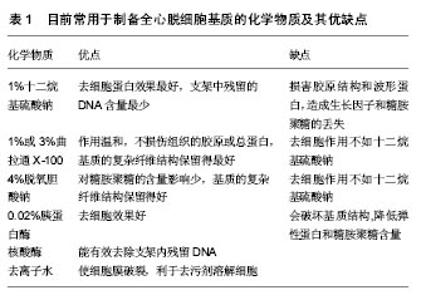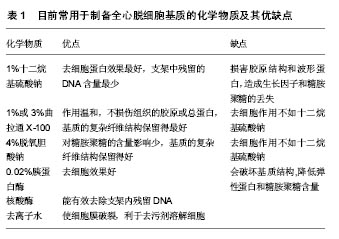Chinese Journal of Tissue Engineering Research ›› 2018, Vol. 22 ›› Issue (6): 964-970.doi: 10.3969/j.issn.2095-4344.0076
Previous Articles Next Articles
Preparation and application of cardiac decellularized matrix scaffolds
- Department of Emergency, Sun Yat-sen Memorial Hospital, Sun Yat-sen University, Guangzhou 510120, Guangdong Province, China
-
Received:2017-09-01Online:2018-02-28Published:2018-02-28 -
Contact:Wang Tong, M.D., Doctoral supervisor, Professor, Chief physician, Researcher, Department of Emergency, Sun Yat-sen Memorial Hospital, Sun Yat-sen University, Guangzhou 510120, Guangdong Province, China -
About author:Wu Quan-hua, Attending physician, Department of Emergency, Sun Yat-sen Memorial Hospital, Sun Yat-sen University, Guangzhou 510120, Guangdong Province, China -
Supported by:the National Natural Science Foundation of China, No. 81070125, 81270213, 81670306, 81700242; the Natural Science Foundation of Guangdong Province, No. 2017A030313503; the Science and Technology Plan Project of Guangdong Province, No. 2017A020215176, 2014A020211002, 2010B031600032; the Fundamental Research Funds for the Central Universities for Young Teacher Training in Sun Yat-sen University, No. 13ykzd16; the Fundamental Research Funds for the Central Universities for Major Projects and Cutting-Edge Emerging Interdisciplinary Cultivation, No. 17ykjc18; the Medical Science Research Foundation of Guangdong Province, No. A2016264, A2017001
CLC Number:
Cite this article
Wu Quan-hua, Chen Xu-xiang, Wang Lei, Wu Hao, Long Hui-bao, Hou Jing-ying, Wang Tong. Preparation and application of cardiac decellularized matrix scaffolds[J]. Chinese Journal of Tissue Engineering Research, 2018, 22(6): 964-970.
share this article
Add to citation manager EndNote|Reference Manager|ProCite|BibTeX|RefWorks

2.1 心脏脱细胞基质支架的制备 利用脱细胞的方法将心脏内驻留的细胞清除,同时保留其细胞外基质成分,例如:Ⅰ型胶原、Ⅲ型胶原、Ⅳ型胶原、粘连蛋白、糖氨聚糖、纤连蛋白等。由于细胞外基质成分在同物种间的相对保守性,基于同物种的脱细胞基质支架材料几乎没有或仅有很少的免疫排斥性。目前常用的制备心脏脱细胞基质的方法有:物理处理、化学方法和生物学处理(酶解法)[15-18]。目前用于制备心脏脱细胞支架常用的化学物质及其优、缺点,见表1。 2.1.1 物理处理 采用-80 ℃的低温或液氮保存,在快速冷冻过程中会在细胞内产生较大形状的冰晶,破坏组织细胞的细胞膜结构,促使细胞裂解破坏。但这种方法还需要通过冲洗和灌流将裂解的细胞从基质中冲洗出来,从而达到脱细胞的目的[19]。 2.1.2 化学方法 使用化学试剂溶解细胞膜的双分子层磷脂,使细胞膜蛋白质变性和破坏核酸。常用的化学试剂有去污剂、酸碱溶液和低渗或高渗溶液。 去污剂(表面活性剂):包括离子型、非离子型和两性表面活性剂。常用的离子型去污剂有十二烷基硫酸钠、脱氧胆酸钠等[20]。十二烷基硫酸钠是目前最常用的心脏细胞洗脱剂,能使蛋白质变性,溶解细胞质和细胞核成分,去细胞效果强,但处理时间过长会破坏细胞外基质的超微结构,破坏胶原的完整性和引起糖胺聚糖的降低。非离子洗涤剂有 Triton-X100和辛基吡喃葡萄糖苷,Triton-X100作用温和,去细胞作用不如十二烷基硫酸钠,但不损伤组织的胶原或总蛋白,对糖胺聚糖含量影响较少。辛基吡喃葡萄糖苷去细胞作用强且能够去除组织的主要免疫原性物质,但会降低糖胺聚糖含量。两性离子去污剂有CHAPS、SB-10和SB-16,容易使蛋白发生变性,主要用于动脉和神经的脱细胞[21]。 酸碱溶液:过氧乙酸或醋酸脱细胞时不影响组织的糖胺聚糖,但会损伤和去除胶原蛋白,降低细胞外基质的强度。碱(氢氧化钠、氢氧化钙)作用强烈,会消除基质内生长因子,使细胞外基质的力学性能明显降低[22],一般不用于心脏脱细胞。 低渗与高渗溶液:低渗溶液通过渗透效应使细胞膜破裂,和去污剂配合使用,有利于去污剂溶解细胞。高渗盐溶液能够增加DNA的溶解度,在脱细胞后期用于清除洗脱支架中残存的核酸成分。 2.1.3 生物处理(酶解法) 常用的去细胞蛋白水解酶有胰蛋白酶、磷脂酶A2和核酸酶。胰蛋白酶最常用,是一种强效的丝氨酸蛋白酶,胰蛋白酶去细胞效果好,但处理时间过长会导致细胞外基质的结构破坏,暴露其抗原成分,大幅度降低弹力蛋白和糖胺聚糖含量。磷脂酶A2能催化甘油磷脂的酯键水解,裂解细胞膜,去除磷脂、去细胞效果好,且不与胶原蛋白和糖胺聚糖发生反应,不损害细胞外基质的超微结构,但残留的磷脂酶A2有细胞毒性,需用磷酸缓冲液冲洗彻底去除[23]。经去污剂处理过的心脏再用核酸内切酶室温下灌洗,能够去除99%的支架内残留DNA[13]。 组织器官去细胞的效果,除了受所选洗脱细胞的材料属性和灌注速度影响,还与组织器官内细胞密度、厚度,组织器官的比重及脂肪含量有关。对于猪等大型动物的心脏,单纯用十二烷基硫酸钠和Triton-X100灌注,脱细胞效果不佳,需综合运用物理法、化学法和酶解法等多种处理方法。2009年,Wainwright等[24]对活体猪心脏进行脱细胞处理,通过-80 ℃低温保存16 h使细胞溶解,复温后用0.02%胰蛋白酶37 ℃灌注2 h,3%Triton-X100灌注2 h,4%脱氧胆酸钠灌注2 h,0.1%过氧乙酸灌注1 h,成功制备猪心脏脱细胞基质支架。为了尽量减少对细胞外基质支架生物化学组成、组织超微结构和力学性能的影响,在有效脱细胞的前提下减少各种脱细胞试剂的浓度或灌注时间尤为重要。在2012至2015年间,Guyette等[13]在制备人心脏脱细胞基质时仍沿用Ott等[12]的方法,用1%十二烷基硫酸钠灌注 168 h,1%Triton-X100灌注24 h,再用核酸内切酶室温下灌注24 h去除残留的DNA。在Sánchez等[25]的文章中亦详细描述了39个人心脏脱细胞基质支架的获取方法。 2.2 心脏脱细胞基质支架的构成成分、特征和质量控制 心脏的细胞外基质支架主要含有Ⅰ、Ⅲ和Ⅳ型胶原、糖胺聚糖、纤连蛋白、层粘连蛋白及少量生长因子[12]。阿利新蓝染色显示,心脏脱细胞基质支架中含有丰富的糖胺聚糖成分,在心脏内、外表面部位相对聚集。糖胺聚糖的亲水性强,能够保持疏松结缔组织中的水分,提供细胞外基质凝胶样特性;糖胺聚糖是多价阴离子,能够调节K+、Na+、Ca2+、Mg2+等阳离子在组织中的分布;研究表明,糖胺聚糖还能够促进血管内皮生长因子的表达,促血管生成及促进细胞生长。用滤纸收集样本(FASP)方法分析细胞外基质中的糖基化蛋白多肽,发现基质中除了含有大量胶原和糖胺聚糖,还含有纤连蛋白和血小板反应蛋白4,这两种蛋白能够促进细胞的增殖、迁移和黏附。基质中的低生长因子基底胶含有丰富的层粘连蛋白、肝素糖蛋白、基质金属蛋白酶和生长因子,可识别细胞表面受体使基膜与细胞紧密结合,决定细胞的极性,影响细胞的代谢、存活、迁移、增殖和分化[26]。 主动脉灌流甲苯胺蓝染色显示,心脏去细胞支架心脏脉管结构保存良好,部分区域能清晰看到三级甚至四级血管结构,血管中的内皮细胞和平滑肌细胞被清除,遗留保存完好的波浪形血管基膜[27]。心脏去细胞支架维持了完整的血管网络系统,再内皮细胞化后能为干细胞或前体细胞群种植培养提供营养物质及氧分,带走代谢物[14]。 人源生物材料存在显著的个体差异,这可能与个体遗传、饮食、环境及由老化引起的差异相关[28]。不同脱细胞基质材料之间的生物分子组成的变化会显着影响其材料的性质,同时也会直接影响其疗效。脱细胞基质材料,尤其是心脏脱细胞基质支架,之前也仅仅是对制备材料的细胞外基质内蛋白含量进行了测定,而没有对所有个体材料的细胞外基质蛋白含量进行比较,更谈不上对心脏基质所有构成成分进行定量检测和比对,这非常不利于全心脏脱细胞基质支架的制备进行质量控制和评估。Johnson等[29]对心脏脱细胞基质支架材料进行了细胞外基质的蛋白含量检测,结果表明这些脱细胞基质主要由纤维胶原蛋白组成,其代表定量蛋白质的70%以上;难以去除细胞的蛋白定量小于总蛋白质含量的1%,对于脱细胞生物材料来说这是非常低的;糖胺聚糖含量存在有明显的个体差异。这种检测为将来制定产品的质量制备标准具有较强的指导意义。这种有针对性的方法将用于脱细胞生物材料产品的标准化评价,不仅用于内部质量控制,而且将允许用于不同处理方法和不同组织源之间及不同实验室获得产品的交叉比较。因为最终,基于生物材料支架的疗效取决于复杂的细胞外基质框架成分,其决定了宿主的免疫应答和最终的治疗是否成功。 2.3 心脏脱细胞基质支架的生物学评价 心脏脱细胞是否成功,主要从以下几个方面评价:细胞成分是否被完全清除、心脏细胞外基质成分水平如何、心脏三维结构和脉管结构是否保存完整等。细胞成分的清除是脱细胞最重要的目的之一,残余的细胞成分会在体外培养细胞时引起细胞相容性问题,在体内应用时引发宿主免疫反应,其中最主要的是一些双链DNA成分。 2.3.1 定性分析评估 通过DAPI或苏木精-伊红免疫荧光染色证明细胞已从基质中被去除,没有细胞核存留。利用电子显微镜观察细胞外基质的超微结构,显示基质纤维紧密排列成束状并交织成网状结构,三维结构没有被破坏。 2.3.2 定量分析评估 脱细胞支架中残存的核酸是再植时引起免疫排斥反应的主要物质,而且核酸的含量容易量化检测,因此DNA残留物的含量成为衡量基质去细胞效果的标准,目前研究公认的标准是[30]:①干质量每毫克细胞外基质组织中双链DNA质量<50 ng;②残留DNA片段应短于200个碱基对。此外还有糖胺聚糖含量检测:与正常心脏组织比较,脱细胞支架的糖胺聚糖含量不会有显著性降低。 White等[31]使用一种非常灵敏的表面分析技术-飞行时间二次离子质谱法(ToF-SIMS)去分析生物支架的脱细胞效果,该技术能够精确检测细胞外基质表面的原子、分子基团和细胞外基质的三维结构,分析发现1%十二烷基硫酸钠处理的组织去除细胞蛋白效果最好,DNA含量最少,但会造成生长因子和糖胺聚糖的丢失,还会损害胶原结构和波形蛋白;3%Triton X-100或4%脱氧胆酸钠处理的组织细胞外基质复杂纤维结构保留得最好。 2.4 心脏脱细胞基质支架的优势 目前,脱细胞基质在心肌组织工程上的应用主要分为3个方向:①基于脱细胞基质片层的“创可贴”心肌组织工程研究;②基于脱细胞基质的可注射性心肌组织工程研究;③基于心脏全器官脱细胞-再细胞化的人工心脏再造研究。在这3个方面的研究中,基于脱细胞基质片层的“创可贴”心肌组织工程研究只能用于外科治疗修复心肌,在临床上创伤大、风险高,应用受到很大限制;基于脱细胞基质的可注射性心肌组织工程研究也只适用于心肌梗死等有局部坏死的心肌修复;而对于心力衰竭等全心功能不全需要等待心脏移植的患者来说,基于心脏全器官脱细胞-再细胞化的人工心脏再造研究可能是最理想的选择[32],因为全心脏脱细胞基质支架提供了一模一样的腔室结构、血管网络、心脏基质、机械特性,更重要的一点是避免了移植后的免疫排斥反应,黏附的细胞能够在类似的微环境中生长和分化[33]。 心脏由心肌细胞、内皮细胞、成纤维细胞、血管平滑肌细胞及一些特殊的传导细胞如起搏细胞、浦肯野氏纤维。成年的人类心脏中大约有40亿个成熟的不再具有分化能力的心肌细胞[34]。因此,体外分离和培养足量的心肌细胞以便形成正常大小成人心脏,是非常困难的。传统的干细胞体外培养中,随着扩增传代次数增加或培养的时间延长,培养的干细胞会逐渐失去自我更新能力和多向分化潜能,说明微环境对维持细胞功能起着非常重要的作用。 心脏脱细胞基质支架的制成,只能说是完成了构建生物心脏的第一步。如何将该支架再细胞化且具有规律搏动及电信号传导的功能,才是心脏脱细胞基质支架进入临床使用的关键所在。Ng等[35]研究了脱细胞心脏中人胚胎干细胞和人胚胎干细胞衍生的人中胚层细胞的分化潜力,这些细胞在脱细胞心脏中培养2周后显示心脏标志物表达上调,证明脱细胞心脏的特性可将干细胞和祖细胞分化为心脏细胞。Robertson等[36]首次通过动脉和静脉输送大鼠主动脉内皮细胞,在整个动脉和静脉床及腔中重新内皮化整个脱细胞心脏的研究。结果显示:与单路策略相比,组合策略(下腔静脉+头臂动脉)递送内皮细胞,能增强脱细胞支架血管的再内皮化;且再内皮化降低了支架血栓发生率,改善了左心室收缩结构的收缩性。Yasui等[37]用新生大鼠心脏细胞重新填充脱细胞心脏,然后用高分辨率摄像机观察自发性跳动的激发传播,活组织成像显示GFP标记心脏细胞通过冠状动脉外渗迁移到间质空间中,虽然人工心脏通常表现出良好的组织稳定的激发传播,但人工心脏也表现出致心律失常倾向。Lu等[38]使用人诱导多能干细胞衍生的多能心血管祖细胞重构小鼠脱心脏基质支架,结果显示小鼠脱细胞心脏表现出自发性收缩、产生机械力并对药物有反应。Sánchez等[39]在脱细胞基质支架的39个人心脏中种植5种不同的细胞,包括人心脏祖细胞、人骨髓间充质细胞、人类内皮细胞、H9c1和HL-1心肌细胞。培养21 d后观察细胞存活、基因表达、组织和/或电耦合。结果发现,人心脏祖细胞和人骨髓间充质细胞表达心肌细胞的基因,但没有发展为心脏细胞的组织形态;人类内皮细胞形成了内膜和脉管系统的内衬;H9c1和HL-1心肌细胞形成新生肌肉束并显示成熟的钙动力学和电耦合。Guyette等[14]通过向脱细胞心脏基质支架的左心室前部和中部前段进行5次心肌内注射(使用-500 μL/注射,总体积为2.5 mL),大约使用5亿的人类诱导多能干细胞衍生心肌细胞,种子细胞在仿生的条件下产生了人心肌组织,显示出电传导、左心室收缩功能和代谢功能。 在不同的微环境中培养心肌干细胞,其增殖分化效果明显不一样。Radisic[40]在没有灌注的二维结构细胞外基质中培养的心肌细胞厚度不能超过50 µm,而Ott等[12]在大鼠脱细胞基质三维结构中灌注培养的心肌细胞厚度达到250 µm-1.1 mm,在人心脏脱细胞基质中培养的心肌厚度可达2.5 mm,说明脱细胞基质支架能够促进干细胞的生长分化和增殖,而且与心肌薄片培养的心肌细胞相比较,脱细胞支架培养的细胞中具有功能收缩特性的细胞数量明显增多,收缩力增强。Ott等[12]在细胞再植培养4 d 后,发现再细胞化的人工心脏开始出现搏动,8 d 后即能实现初步的泵血功能-相当于成年大鼠左心室射血分数的2%或人类胎儿(约4 个月)左心室射血分数的25%。2012 年,Patel等[41]分析了心脏脱细胞基质支架的3D结构、几何构成、组成成分和血管结构,并将人骨髓干细胞作为种子细胞种植于心脏脱细胞基质中,结果表明,脱细胞基质可促进干细胞的黏附、排列和生长分化。宋玫等[42]利用脂肪组织去细胞制备的脱细胞基质支架与脂肪来源基质细胞共培养,细发现胞外基质能够诱导接种的外源性脂肪干细胞分化增殖,同时还可诱导移植周围宿主的脂肪前体细胞分化增殖。Broadie等[43]发现细胞外基质成分中存在整合素、多配体聚糖等横跨膜受体,可通过配体与受体之间的相互作用调控信号转导通路进而影响细胞分化、增殖。 由于人源性心脏缺乏及伦理学的制约,也有研究者尝试对猪心脏进行脱细胞处理,猪心脏来源广泛,易于获取,不存在伦理学限制,具有广阔的应用前景。猪心脏和人心脏的结构基本一致,大小也相差无几,是理想的移植材料。Weymann等[44]对10个猪心脏采用离子型去污剂进行脱细胞处理,亦得到了理想的脱细胞心脏基质支架材料,该材料亦洗脱了几乎所有的细胞成分,保留了细胞外基质成分;然后使用新生鼠心肌细胞和人脐带血内皮细胞对脱细胞支架进行再细胞化处理,可观察到冠状动脉血管的再内皮化和心肌电活动,为组织化人工生物心脏的构建提供了一个新的选择。Kitahara等[45]的研究使用骨髓间充质干细胞对猪脱细胞基质支架再细胞化,也得到了类似结果。 最接近临床的实验在近期完成,Kitahara等[45]将灌注了骨髓间充质干细胞的脱细胞基质猪心脏的主动脉接入正常猪腹主动脉,上腔静脉接入正常猪的下腔静脉(不是接在猪心脏原来的正常位置,仅供实验观察用),3 d后摘下脱细胞基质猪心脏,可观察到冠状动脉内血栓形成和炎症细胞浸润,以及骨髓间充质干细胞向基质内的扩展。 "

| [1] | Zhang Tongtong, Wang Zhonghua, Wen Jie, Song Yuxin, Liu Lin. Application of three-dimensional printing model in surgical resection and reconstruction of cervical tumor [J]. Chinese Journal of Tissue Engineering Research, 2021, 25(9): 1335-1339. |
| [2] | Zeng Yanhua, Hao Yanlei. In vitro culture and purification of Schwann cells: a systematic review [J]. Chinese Journal of Tissue Engineering Research, 2021, 25(7): 1135-1141. |
| [3] | Xu Dongzi, Zhang Ting, Ouyang Zhaolian. The global competitive situation of cardiac tissue engineering based on patent analysis [J]. Chinese Journal of Tissue Engineering Research, 2021, 25(5): 807-812. |
| [4] | Wu Zijian, Hu Zhaoduan, Xie Youqiong, Wang Feng, Li Jia, Li Bocun, Cai Guowei, Peng Rui. Three-dimensional printing technology and bone tissue engineering research: literature metrology and visual analysis of research hotspots [J]. Chinese Journal of Tissue Engineering Research, 2021, 25(4): 564-569. |
| [5] | Chang Wenliao, Zhao Jie, Sun Xiaoliang, Wang Kun, Wu Guofeng, Zhou Jian, Li Shuxiang, Sun Han. Material selection, theoretical design and biomimetic function of artificial periosteum [J]. Chinese Journal of Tissue Engineering Research, 2021, 25(4): 600-606. |
| [6] | Liu Fei, Cui Yutao, Liu He. Advantages and problems of local antibiotic delivery system in the treatment of osteomyelitis [J]. Chinese Journal of Tissue Engineering Research, 2021, 25(4): 614-620. |
| [7] | Li Xiaozhuang, Duan Hao, Wang Weizhou, Tang Zhihong, Wang Yanghao, He Fei. Application of bone tissue engineering materials in the treatment of bone defect diseases in vivo [J]. Chinese Journal of Tissue Engineering Research, 2021, 25(4): 626-631. |
| [8] | Zhang Zhenkun, Li Zhe, Li Ya, Wang Yingying, Wang Yaping, Zhou Xinkui, Ma Shanshan, Guan Fangxia. Application of alginate based hydrogels/dressings in wound healing: sustained, dynamic and sequential release [J]. Chinese Journal of Tissue Engineering Research, 2021, 25(4): 638-643. |
| [9] | Chen Jiana, Qiu Yanling, Nie Minhai, Liu Xuqian. Tissue engineering scaffolds in repairing oral and maxillofacial soft tissue defects [J]. Chinese Journal of Tissue Engineering Research, 2021, 25(4): 644-650. |
| [10] | Xing Hao, Zhang Yonghong, Wang Dong. Advantages and disadvantages of repairing large-segment bone defect [J]. Chinese Journal of Tissue Engineering Research, 2021, 25(3): 426-430. |
| [11] | Chen Siqi, Xian Debin, Xu Rongsheng, Qin Zhongjie, Zhang Lei, Xia Delin. Effects of bone marrow mesenchymal stem cells and human umbilical vein endothelial cells combined with hydroxyapatite-tricalcium phosphate scaffolds on early angiogenesis in skull defect repair in rats [J]. Chinese Journal of Tissue Engineering Research, 2021, 25(22): 3458-3465. |
| [12] | Wang Hao, Chen Mingxue, Li Junkang, Luo Xujiang, Peng Liqing, Li Huo, Huang Bo, Tian Guangzhao, Liu Shuyun, Sui Xiang, Huang Jingxiang, Guo Quanyi, Lu Xiaobo. Decellularized porcine skin matrix for tissue-engineered meniscus scaffold [J]. Chinese Journal of Tissue Engineering Research, 2021, 25(22): 3473-3478. |
| [13] | Mo Jianling, He Shaoru, Feng Bowen, Jian Minqiao, Zhang Xiaohui, Liu Caisheng, Liang Yijing, Liu Yumei, Chen Liang, Zhou Haiyu, Liu Yanhui. Forming prevascularized cell sheets and the expression of angiogenesis-related factors [J]. Chinese Journal of Tissue Engineering Research, 2021, 25(22): 3479-3486. |
| [14] | Liu Chang, Li Datong, Liu Yuan, Kong Lingbo, Guo Rui, Yang Lixue, Hao Dingjun, He Baorong. Poor efficacy after vertebral augmentation surgery of acute symptomatic thoracolumbar osteoporotic compression fracture: relationship with bone cement, bone mineral density, and adjacent fractures [J]. Chinese Journal of Tissue Engineering Research, 2021, 25(22): 3510-3516. |
| [15] | Liu Liyong, Zhou Lei. Research and development status and development trend of hydrogel in tissue engineering based on patent information [J]. Chinese Journal of Tissue Engineering Research, 2021, 25(22): 3527-3533. |
| Viewed | ||||||
|
Full text |
|
|||||
|
Abstract |
|
|||||